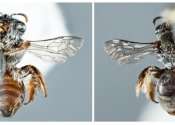New unusual bee species discovered with dog-like snout
A new native bee species with a dog-like "snout" has been discovered in Perth bushland though Curtin-led research that sheds new light on our most important pollinators.

A new native bee species with a dog-like "snout" has been discovered in Perth bushland though Curtin-led research that sheds new light on our most important pollinators.
Plants & Animals
Oct 31, 2022
0
1956

(PhysOrg.com) -- UConn marine scientist Ann Bucklin headed one of the projects, surveying zooplankton around the world.
Plants & Animals
Apr 20, 2010
0
0
(AP) -- Restaurants around the world will soon use new DNA technology to assure patrons they are being served the genuine fish fillet or caviar they ordered, rather than inferior substitutes, an expert in genetic identification ...
Other
Nov 27, 2011
14
0

The storage of light-encoded messages on film and compact disks and as holograms is ubiquitous---grocery scanners, Netflix disks, credit-card images are just a few examples. And now light signals can be stored as patterns ...
Quantum Physics
May 29, 2012
4
0

A major South Korean retailer owned by British giant Tesco has opened a virtual store in a busy Seoul subway station, for increasingly sophisticated smartphone users to order groceries and more.
Hi Tech & Innovation
Aug 31, 2011
0
0

Two New York City high school students exploring their homes using the latest high-tech DNA analysis techniques were astonished to discover a veritable zoo of 95 animal species surrounding them, in everything from fridges ...
Cell & Microbiology
Dec 28, 2009
7
0

An invisible quick response (QR) code has been created by researchers in an attempt to increase security on printed documents and reduce the possibility of counterfeiting, a problem which costs governments and private industries ...
Nanomaterials
Sep 11, 2012
1
0
.jpg)
Research into the structure and development of flowers and inflorescences has revealed that traditional descriptive methods are often inadequate. Scientists at Kew have therefore suggested revisions to floral formula and ...
Plants & Animals
Jan 7, 2011
0
0

Researchers at the University of Leeds are developing a way to 'barcode' viral diseases to rapidly test new outbreaks for potentially lethal mutations.
Cell & Microbiology
May 13, 2012
0
0

Using a new technology developed at MIT, diagnosing lung cancer could become as easy as inhaling nanoparticle sensors and then taking a urine test that reveals whether a tumor is present.
Bio & Medicine
Jan 5, 2024
0
153
A barcode is an optical machine-readable representation of data, which shows data about the object to which it attaches. Originally barcodes represented data by varying the widths and spacings of parallel lines, and may be referred to as linear or 1 dimensional (1D). Later they evolved into rectangles, dots, hexagons and other geometric patterns in 2 dimensions (2D). Although 2D systems use a variety of symbols, they are generally referred to as barcodes as well. Barcodes originally were scanned by special optical scanners called barcode readers; later, scanners and interpretive software became available on devices including desktop printers and smartphones.
The first use of barcodes was to label railroad cars, but they were not commercially successful until they were used to automate supermarket checkout systems, a task for which they have become almost universal. Their use has spread to many other tasks that are generically referred to as automatic identification and data capture (AIDC). The very first scanning of the now ubiquitous Universal Product Code (UPC) barcode was on a pack of Wrigley Company chewing gum in June 1974.
Other systems have made inroads in the AIDC market, but the simplicity, universality and low cost of barcodes has limited the role of these other systems until the first decade of the 21st century, over 40 years after the introduction of the commercial barcode, with the introduction of technologies such as radio frequency identification, or RFID.
This text uses material from Wikipedia, licensed under CC BY-SA